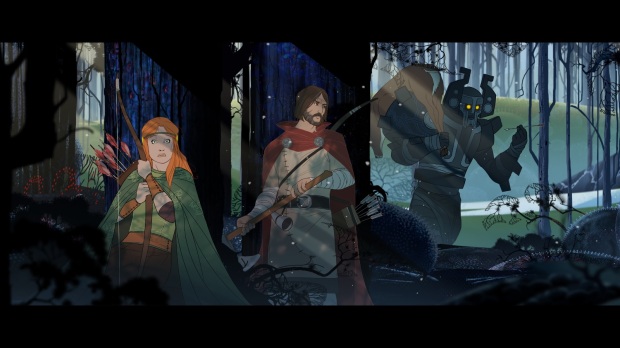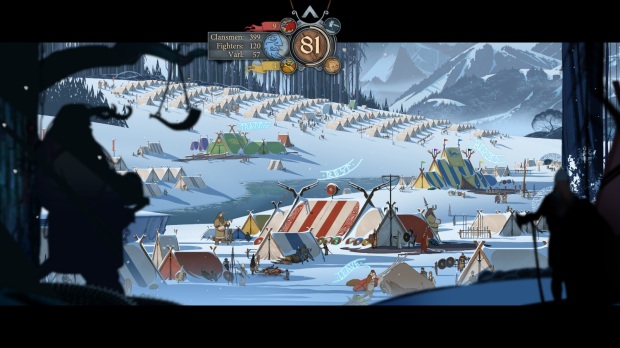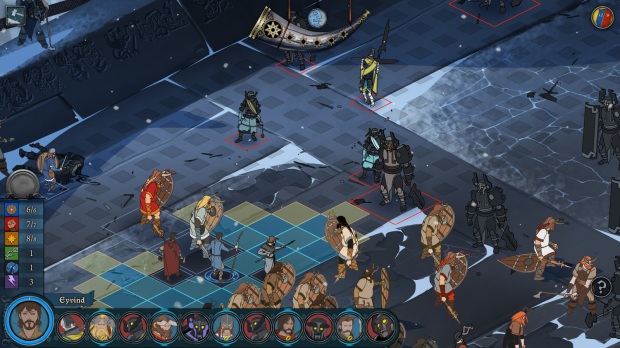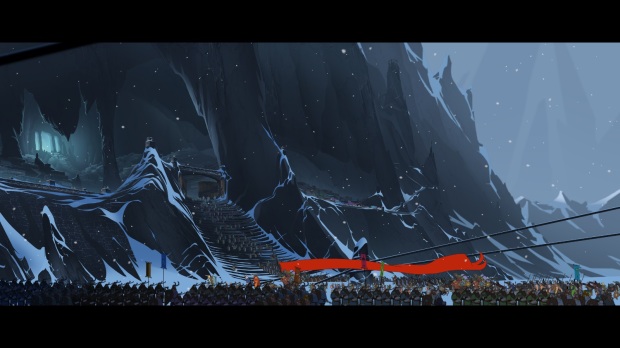PLATFORM: Windows – PC ¦ DEVELOPER: Stoic ¦ PUBLISHER: Versus Evil
RELEASE DATE: 14/1/2014
Time is the enemy. Fighting time is as futile as fighting air – you cannot win, so why try? The Banner Saga is a fight against time, and sure enough I constantly felt like I was losing. So why did I keep trying? Perhaps it was my innate distaste of fatalism, or perhaps it was simply that losing has never looked so beautiful.
Created by new developer Stoic, The Banner Saga displays a level of visual polish to be revered by indie and mainstream developers alike. This is impressive but not entirely surprising, as while Stoic is a young studio, it is a studio made up of experienced pros, the likes of which have worked for titans such as Bioware, Retro Studios and…NASA?
As would be expected from a team with such an impressive résumé, the world of The Banner Saga is artistically very well realised. It is gorgeous, and the world is dripping with rich, genuinely interesting lore.
Set in an unforgiving snow scape, inhabited by nomadic Vikings, immortal giants called Varl and shambling monstrosities known as Dredge, the story of The Banner Saga is understandably bleak. The main goal is to lead a caravan of warriors and clansmen to safe refuge – managing resources to avoid starvation and fatigue, while simultaneously attempting to outmanoeuvre the ever-present threat of the Dredge. Times are hard, and hard decisions must be made to survive. Amidst this strife it is difficult to perceive a happy ending, which is fortunate, because there is no happy ending. The Banner Saga is a game about struggle, death, loss and resource management.
This point is driven home early. Unfortunately, The Banner Saga fails to deliver on the promise of what could have been an interesting exercise in choice based gameplay. Your decisions, which have a direct impact on who lives and dies, never seem to bear the weight of their consequences. As a result it becomes too easy to switch off emotionally. There are several reasons for this, but the most obvious are the seemingly arbitrary text-based decisions you are required to make when guiding the caravan. These often have something to do with rationing supplies or choosing whether or not to face an enemy head on. But on some occasions they can lead to the permanent death of your battle units – outside of battle. In a game about risk management this would usually be acceptable, but the flavour text describing a possible life and death scenario often does not reflect the impact your decision can have. As a result the experience as a whole comes across as random, like a choose-your-own adventure novel – you picked option C, turn to page 37 to die. The way your heroes can be so casually tossed aside in a text prompt makes them feel like an expendable resource – which is no-doubt the point. However, the same can be said of losses to the caravan. Clansmen, fighters and Varl can all die due to a lack of supplies or during confrontations with Dredge, but the only indicator of this ‘tragic loss’ is that a number at the top of the screen changes. Any obligatory guilt felt from a decision that caused deaths fades almost immediately, as there is no real consequence other than a smaller tally of clansmen and a slight blow to morale. The numbers in your caravan ultimately don’t matter – they don’t contribute anything substantial – so why care? In the end the only number that counts is your renown.
Renown is The Banner Saga’s answer to resource management. It acts as a universal currency – used for everything, from buying food and equipment to levelling up your characters. Because of this, there will never be enough to go around. It is impossible to keep everyone fed and at the same time keep your battle units well equipped. This is obviously an attempt by Stoic to add a sense of consequence to your actions. However, when said consequences are so farcical, there is no reason not to sacrifice lives to be better equipped for combat. And you will want to be better equipped for combat.
Time not spent in dialogue windows, or managing your caravan will be spent fighting in tense, deliberately paced encounters. Opposite to the story, which fails to ever establish a sense of weight to your decisions, the combat insists on it from the very beginning. In battle, every decision matters. Careful positioning and attention to the turn order are essential to achieving victory, and the AI won’t hesitate to punish players who don’t consider these factors – even on normal difficulty. To add further challenge, defeating enemies isn’t as simple as reducing an opponent’s health to zero. All units have a health meter, which doubles as their strength, dictating how much damage they can inflict, as well as an armour rating which must first be lowered to do any substantial damage to their health. This makes for some interesting tactical opportunities, as it is necessary to decide whether to go after an enemy’s strength or armour as the situation dictates. Overall there is a more considered mentality in the design of the combat that harkens back to unforgiving strategy games of old. It has a feel of permanence that makes it a far deeper and more gratifying experience than the story.
CONCLUSION
Stoic have created a world with a wonderful sense of tone and place, and it looks absolutely stunning – I just wish I wanted to spend more time in it. The lore and art are both rich and well-conceived. And the combat has a level of depth that once fully comprehended makes for a rewarding diversion from the narrative. However, the story itself lacks finesse. It never made me feel the weight of my decisions, and so I couldn’t help but feel emotionally disconnected – by the end of the game, I just wanted it to be over. For patient gamers, or those that need to scratch the itch that only a strategy game can, there is something here – a beautiful, shaky journey of promise. But for those seeking something more, perhaps this is a Saga better left untold.




This game actually looks pretty cool. I might check it out sometime.
It’s certainly worth a play if you dig strategy RPGs. Obviously the art is great, and I didn’t mention it in my review but
it has a pretty good soundtrack as well.
Thanks, I do love strategy RPGs.